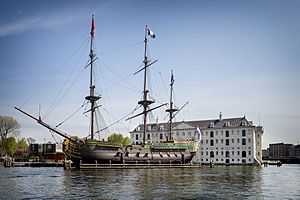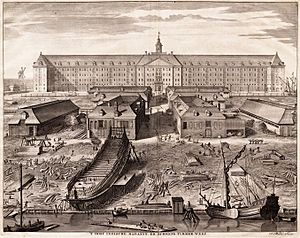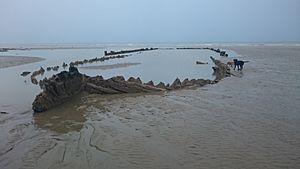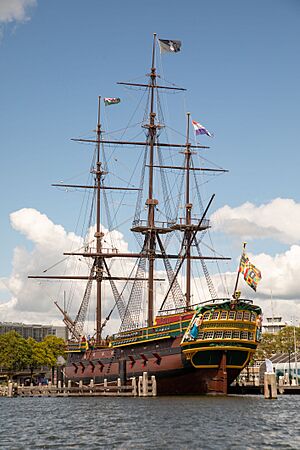Amsterdam (1748) facts for kids

The 1990 ship replica of the Amsterdam in front of the Netherlands Maritime Museum in Amsterdam
|
|
| History | |
|---|---|
| Name | Amsterdam |
| Namesake | The city of Amsterdam |
| Owner |
|
| Completed | 1748 |
| Maiden voyage | Texel–Batavia |
| Fate | Wrecked in a storm in the English Channel on 26 January 1749 |
| General characteristics | |
| Type | East Indiaman |
| Displacement | 1,100 tons |
| Length | 48.0 m (157 ft 6 in) |
| Beam | 11.5 m (37 ft 9 in) |
| Height | 56.0 m (183 ft 9 in) |
| Draught | 5.5 m (18 ft 1 in) |
| Armament | 42 guns |
The Amsterdam was a large cargo ship from the 1700s. It belonged to the Dutch East India Company, a powerful trading company. This ship was built to carry goods between the Dutch Republic and places far away in the East Indies.
In January 1749, the Amsterdam began its first journey from Texel to Batavia (which is now Jakarta, Indonesia). Sadly, it ran into a terrible storm in the English Channel. The ship was wrecked on January 26, 1749.
The remains of the ship were found in 1969 near Hastings, England. Sometimes, when the tide is very low, you can still see parts of the wreck. Today, a full-size copy of the Amsterdam is on display in Amsterdam, where visitors can explore what life was like on an 18th-century sailing ship.
Contents
What Was the Amsterdam Ship?
The Amsterdam was a special type of ship called an East Indiaman. These ships were like the cargo planes of their time. They were built for long voyages between the Dutch Republic and the trading posts in the East Indies.
On its way out, the Amsterdam would carry important supplies. These included guns and bricks for building settlements. It also carried silver and gold coins to buy goods in Asia. On the return journey, the ships were filled with valuable items. These included spices, beautiful fabrics, and china.
Both ways, the ships carried food, clothes, and tools for the sailors and soldiers. A journey to the East Indies could take about eight months. On the way out, about 240 people would be on board. On the way back, there were usually around 70 people.
The Amsterdam was built in a shipyard in Amsterdam. It was made from strong oak wood.
The First and Last Journey
The Amsterdam's first trip was planned from the Dutch island of Texel to Batavia in the East Indies. The ship was led by Captain Willem Klump, who was 33 years old. There were 203 crew members, 127 soldiers, and 5 passengers on board.
The ship carried a lot of cargo. This included textiles, wine, heavy stone ballast, cannons, paper, pens, pipes, and household items. It also had 27 chests filled with silver guilder coins. All these goods would be worth millions of euros today!
The ship tried to leave on November 15, 1748, but strong winds forced it back. A second attempt on November 21 also failed. Finally, on January 8, 1749, the Amsterdam set sail for the third time.
However, the ship faced a powerful storm in the English Channel. For many days, it struggled against the strong westerly winds. It couldn't get past Beachy Head near Eastbourne. During this time, many people on board became sick. There was also a mutiny, which is when the crew rebels against the captain.
Eventually, the ship's rudder broke off. Without a rudder, the ship couldn't be steered. Helpless in the storm, it ran aground in the mud and sand. This happened in the bay of Bulverhythe, near Hastings, on January 26, 1749.
The ship slowly sank into the mud. Much of its bottom part, called the keel, is still there today. It is perfectly preserved by the mud. Some of the cargo, like the silver coins, was taken off the ship for safety. People tried to take things from the wreck, and soldiers had to help keep order. The crew members were looked after locally before returning to the Dutch Republic.
Discovering the Shipwreck
In 1969, the Amsterdam shipwreck was found. A very low spring tide exposed parts of it. This wreck is special because it's the best-preserved VOC ship ever discovered. An archaeologist named Peter Marsden first studied the wreck. He suggested that more digging should be done.
The wreck site was officially protected in 1974. This means it's against the law to disturb it.
A group called the VOC Ship Amsterdam Foundation began to study the wreck. Major excavations happened in 1984, 1985, and 1986. During these digs, many amazing items were found. Even though the wreck is mostly buried in the sand and mud of the beach, divers did much of the work. They even used a small tower built near the wreck.
Some of the items found are now on display. You can see them at the Shipwreck Museum in Hastings, UK. One of the ship's anchors is there. Another anchor is displayed as public art in St Katharine Docks in London. Because the wreck is protected, it's forbidden to dive on it or remove any parts or items. However, you can sometimes see the ship's timbers at very low tides.
A Replica Ship for Visitors
A full-size copy of the Amsterdam was built between 1985 and 1990. About 300 volunteers helped build it. They used both modern tools and tools from the 18th century. The replica is made of Iroko wood.
Today, this replica is docked next to the Netherlands Maritime Museum in Amsterdam. Visitors to the museum can go inside and explore the ship. It's a great way to imagine what life was like for sailors hundreds of years ago.
For many years, people hoped the original shipwreck could be fully dug up. They wanted to bring it back to Amsterdam for display, like the famous Regalskeppet Vasa in Sweden or the Mary Rose in Portsmouth. However, the money needed for such a huge project was not available. Many parts of the original ship, including several decks and the bowsprit, are still buried in the mud. They are in remarkably good condition because the mud naturally preserves them. Much of the cargo is also still on board.





